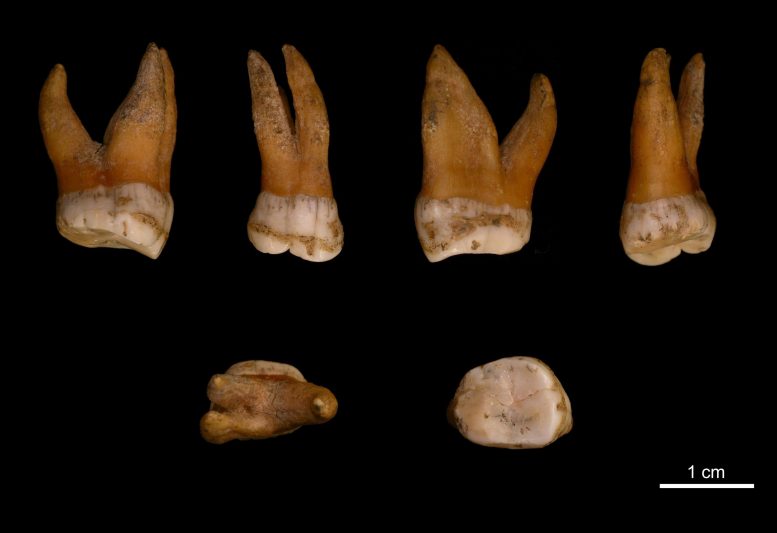通过比较古人类的Y染色体与现代人的Y染色体,研究小组发现,尼安德特人和现代人的Y染色体彼此之间的相似性比与Denisovan Y染色体更相似。 “这对我们来说是一个惊喜。通过研究他们的常染色体DNA,我们可以知道尼安德特人和丹尼索瓦人之间有着密切的联系,而当今生活的人类是他们更远的进化表亲。在我们第一次查看数据之前,我们希望它们的Y染色体会显示出相似的图像。”研究的主要作者马丁·彼得(Martin Petr)说。研究人员还计算出,尼安德特人和现代人类Y染色体的最新共同祖先大约生活在370,000年前,比以前想象的要新得多。
到现在为止,众所周知,由于尼安德特人与现代人类之间的杂交大约在50,000-70,000年前,所有具有非非洲血统的人都携带少量尼安德特人DNA,这是在现代人类迁出非洲并开始传播后不久世界各地。但是,尼安德特人是否也可能携带一些现代人类DNA一直是一个争论的问题。这些Y染色体序列现在提供了新的证据,表明尼安德特人和早期的现代人类在非洲大批移民之前就已经相遇并交换了基因-可能早在370,000年前,当然早在100,000年前。这意味着当时与欧亚大陆早期人类有密切关系的某些人口一定已经在欧亚大陆。令人惊讶的是,这种杂交导致了原始尼安德特人Y染色体被现代人类替换,这种模式类似于在早期研究中对尼安德特人线粒体DNA的观察。
从早期现代人类中选择Y染色体
首先,早期尼安德特人的Y染色体和mtDNA的完全替换令人费解,因为这样的替换事件不太可能仅凭偶然发生。然而,研究人员使用计算机模拟结果表明,已知的尼安德特人小种群可能导致其Y染色体上有害突变的积累,这将降低其进化适应性。这与极小的人口规模和近交有时会增加某些疾病的发病率的情况非常相似。 “我们推测,鉴于Y染色体在繁殖和繁殖力中的重要作用,尼安德特人Y染色体进化适应性较低,可能导致自然选择偏爱早期现代人类的Y染色体,最终导致了它们的替代”。马丁·彼得(Martin Petr)说。
该研究的资深作者珍妮特·凯尔索(Janet Kelso)乐观地认为,可以在不久的将来检验这种替代假说:“如果我们能够从假想的早期渗入事件之前存在的尼安德特人中检索Y染色体序列,例如430,000岁我们预测来自西班牙Sima de los Huesos的尼安德特人仍将拥有原始的尼安德特人Y染色体,因此与Denisovans相比,与现代人类更相似。”
By comparing the archaic human Y chromosomes to each other and to the Y chromosomes of people living today, the team found that Neandertal and modern human Y chromosomes are more similar to one another than they are to Denisovan Y chromosomes. “This was quite a surprise to us. We know from studying their autosomal DNA that Neanderthals and Denisovans were closely related and that humans living today are their more distant evolutionary cousins. Before we first looked at the data, we expected that their Y chromosomes would show a similar picture,” says Martin Petr, the lead author of the study. The researchers also calculated that the most recent common ancestor of Neandertal and modern human Y chromosomes lived around 370,000 years ago, much more recently than previously thought.
It is by now well established that all people with non-African ancestry carry a small amount of Neandertal DNA as a result of interbreeding between Neanderthals and modern humans approximately 50,000-70,000 years ago, quite shortly after modern humans migrated out of Africa and started spreading around the world. However, whether Neanderthals might also carry some modern human DNA has been a matter of some debate. These Y chromosome sequences now provide new evidence that Neanderthals and early modern humans met and exchanged genes before the major out of Africa migration — potentially as early as 370,000 years ago and certainly more than 100,000 years ago. This implies that some population closely related to early modern humans must already have been in Eurasia at that time. Surprisingly, this interbreeding resulted in the replacement of the original Neandertal Y chromosomes with those of early modern humans, a pattern similar to what has been seen for Neandertal mitochondrial DNA in an earlier study.
Selection for Y chromosomes from early modern humans
At first, the complete replacement of both Y chromosomes and mtDNA of early Neanderthals was puzzling, as such replacement events are quite unlikely to occur by chance alone. However, the researchers used computer simulations to show that the known small size of Neandertal populations may have led to an accumulation of deleterious mutations in their Y chromosomes which would reduce their evolutionary fitness. This is quite similar to situations where extremely small population sizes and inbreeding can sometimes increase the incidence of some diseases. “We speculate that given the important role of the Y chromosome in reproduction and fertility, the lower evolutionary fitness of Neandertal Y chromosomes might have caused natural selection to favor the Y chromosomes from early modern humans, eventually leading to their replacement” says Martin Petr.
Janet Kelso, the senior author of the study, is optimistic that this replacement hypothesis could be tested in the near future: “If we can retrieve Y chromosome sequences from Neanderthals that lived prior to this hypothesized early introgression event, such as the 430,000 year old Neanderthals from Sima de los Huesos in Spain, we predict that they would still have the original Neandertal Y chromosome and will therefore be more similar to Denisovans than to modern humans.”
Reference: “The evolutionary history of Neanderthal and Denisovan Y chromosomes” by Martin Petr, Mateja Hajdinjak, Qiaomei Fu, Elena Essel, Hélène Rougier, Isabelle Crevecoeur, Patrick Semal, Liubov V. Golovanova, Vladimir B. Doronichev, Carles Lalueza-Fox, Marco de la Rasilla, Antonio Rosas, Michael V. Shunkov, Maxim B. Kozlikin, Anatoli P. Derevianko, Benjamin Vernot, Matthias Meyer and Janet Kelso, 25 September 2020, Science.
DOI: 10.1126/science.abb6460
